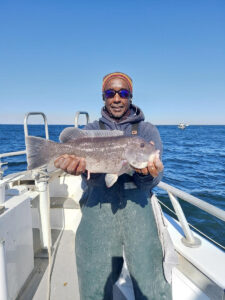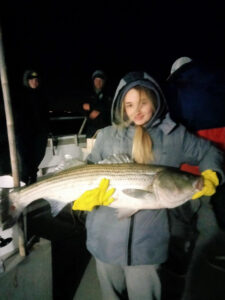As temperatures drop in NYC during the winter, many fish species head south for the season. This can lead to a decrease in your fishing options until spring returns, but there are still options. You can plan an ice fishing trip in freshwater, or take a boat fishing trip into Jamaica Bay, Rockaway Beach, and off the New Jersey coast to fish for bottom feeders, potentially catching ling, cod, and blackfish.
But few fish are as fun to catch as striped bass, and if you know where to look, you can make stripers the foundation of your wintertime fishing in New York. Alternatively, if you are coming into the area for a trip, winter fishing in the area is an excellent activity for your vacation.
How to Hook Striped Bass in NYC During the Winter
Stripers are the perfect winter fish because of their migratory habits. During the summer, these fish prefer colder waters up north off the coast of New England. Striped bass move south for the winter, making them plentiful off the coast of NYC and NJ during the early winter and early spring. You will most often find them in bays and estuaries where the water is warmer.
There are also holdovers, or bass that stay in local waters so long as they do not freeze. They live in the bays around NYC.
Hooking a striper is not generally hard, especially in winter when food is scarce. But they fight back when caught and reeling them in can be a challenge. Early winter stripers can be especially large at more than 50 pounds, although later season fish may be slightly smaller.
To make the most of your fishing trip for stripers during the winter time, you will need to:
- Find the Right Spot – This will depend on whether you are catching migratory stripers or holdovers. Bays, estuaries, and the mouths of rivers are popular places for striped bass during the winter, and they will often feed around bridges or reefs. Because food is scarce during the winter, bass will more often be out in the open hunting instead of hiding.
- Look for Baitfish – Stripers will go wherever food is. While you are out, look for baitfish or hovering seagulls that are eating baitfish. In almost every case, striped bass will be there eating the baitfish as well.
- Use the Right Fishing Gear – A strong line with a metal filament or lead core is useful when stripers fight back. Jigs, plugs, and umbrella rigs are some of the best tackle for striped bass, and many fishermen will also use a high-low rig when schoolie bass are around. For live bait, eels, squid, clams, porgies, and herring will all work depending on the area.
While anglers can catch stripers from shores or docks during the spring and summer, striped bass fishing from a boat makes it easier to get to the locations where bass are overwintering. Marilyn Jean Fishing runs daily fishing trips for striped bass with options for half day and evening trips. Our trips get you to the best locations around NYC for stripers, and provide the bait you need to catch them.
The other advantage to winter fishing aboard one of our boats is comfort. With heating and lighting, you do not need to endure hours of the cold and dark to hook stripers in NYC. Check out our calendar to schedule your winter striped bass trip with Marilyn Jean Fishing.


